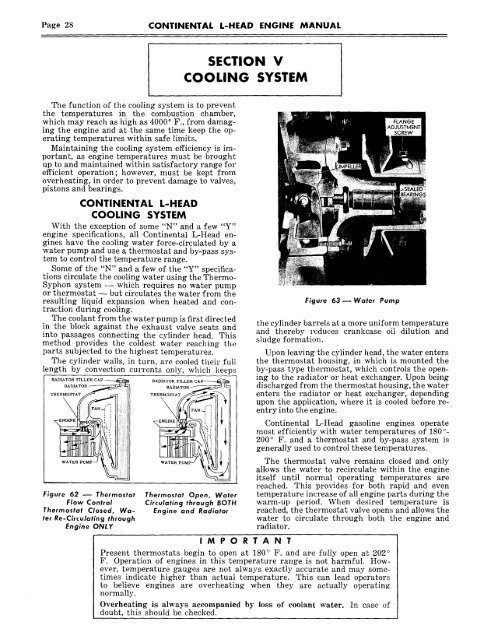Continental L-Head Overhaul Manual - Igor Chudov
Continental L-Head Overhaul Manual - Igor Chudov
Continental L-Head Overhaul Manual - Igor Chudov
You also want an ePaper? Increase the reach of your titles
YUMPU automatically turns print PDFs into web optimized ePapers that Google loves.
Page 28 CONTINENTAL L-HEAD ENGINE MANUAL<br />
The function of the cooling system is to prevent<br />
the temperatures in the combustion chamber,<br />
which may reach as high as 4000 ° F., from damaging<br />
the engine and at the same time keep the opcrating<br />
temperatures within safe limits.<br />
Maintaining the cooling system efficiency is important,<br />
as engine temperatures must be brought<br />
up to and maintained within satisfactory range for<br />
efficient operation; however, must be kept from<br />
overheating, in order to prevent damage to valves,<br />
pistons and bearings.<br />
CONTINENTAL L-HEAD<br />
COOLING SYSTEM<br />
With the exception of some "N" and a few "Y"<br />
engine specifications, all .<strong>Continental</strong> L-<strong>Head</strong> engines<br />
have the cooling water force-circulated by a<br />
water pump and use a thermostat and by-pass system<br />
to control the temperature range.<br />
Some of the "N" and a few of the "Y" specifications<br />
circulate the cooling water using the Thermo-<br />
Syphon system -- which requires no water pump<br />
or thermostat -- but circulates the water from the<br />
resulting liquid expansion when heated and contraction<br />
during cooling.<br />
The coolant from the water pump is first directed<br />
in the block against the exhaust valve seats and<br />
into passages connecting the cylinder head. This<br />
method provides the coldest water reaching the<br />
parts subjected to the highest temperatures.<br />
The cylinder walls, in turn, are cooled their full<br />
length by convection currents only, which kee)s<br />
P~DI~TOR FILLER CAP<br />
RADIATOR<br />
~<br />
THERMOSTAT<br />
Figure 62 ~ Thermostat<br />
Flow Control<br />
Thermostat Closed, Water<br />
Re-Circulating through<br />
Engine ONLY<br />
RADIATOR<br />
ENGINE<br />
SECTION V<br />
COOLING SYSTEM<br />
Thermostat Open, Water<br />
Circulating through BOTH<br />
Engine and Radiator<br />
Figure 63 ~ Water Pump<br />
the cylinder barrels at a more uniform temperature<br />
and thereby reduces crankcase oil dilution and<br />
sludge formation.<br />
Upon leaving the cylinder head, the water enters<br />
the thermostat housing, in which is mounted the<br />
by-pass type thermostat, which controls the opening<br />
to the radiator or heat exchanger. Upon being<br />
discharged from the thermostat housing, the water<br />
enters the radiator or heat exchanger, depending<br />
upon the application, where it is cooled before reentry<br />
into the engine.<br />
<strong>Continental</strong> L-<strong>Head</strong> gasoline engines operate<br />
most efficiently °- with water temperatures of 180<br />
200 ° F. and a thermostat and by-pass system is<br />
generally used to control these temperatures.<br />
The thermostat valve remains closed and only<br />
allows the water to recirculate within the engine<br />
itself until normal operating temperatures are<br />
reached. This provides for both rapid and even<br />
temperature increase of all engine parts during the<br />
warm-up period. When desired temperature is<br />
reached, the thermostat valve opens and allows the<br />
water to circulate through both the engine and<br />
radiator.<br />
IMPORTANT<br />
Present thermostats begin to open at 180 ° F. ° and are fully open at 202<br />
F. Operation of engines in this temperature range is not harmful. However,<br />
temperature gauges are not always exactly accurate and may sometimes<br />
indicate higher than actual temperature. This can lead operators<br />
to believe engines are overheating when they are actually operating<br />
normally.<br />
Overheating is always accompanied by loss of coolant water. In case of<br />
doubt, this should be checked.
















